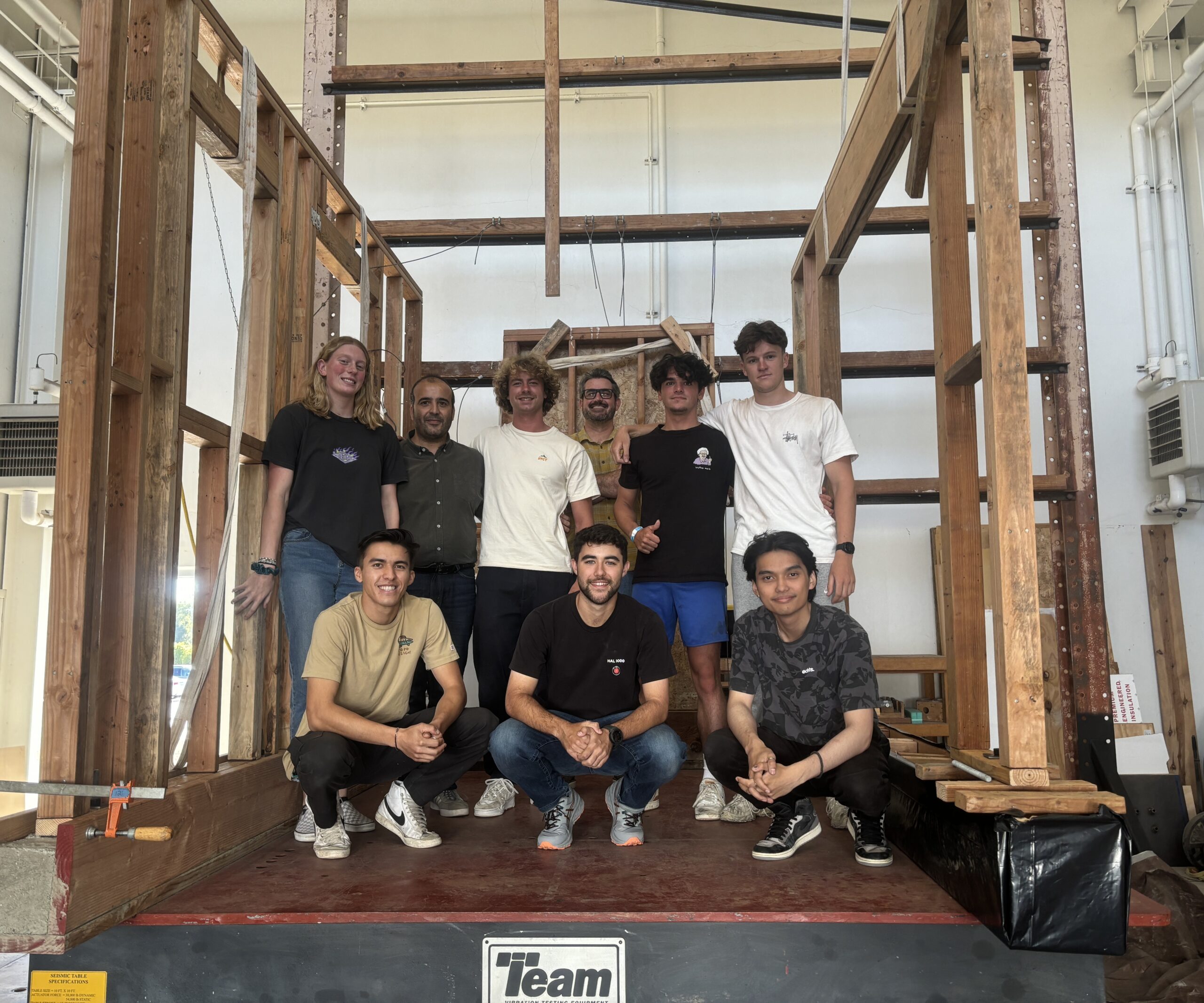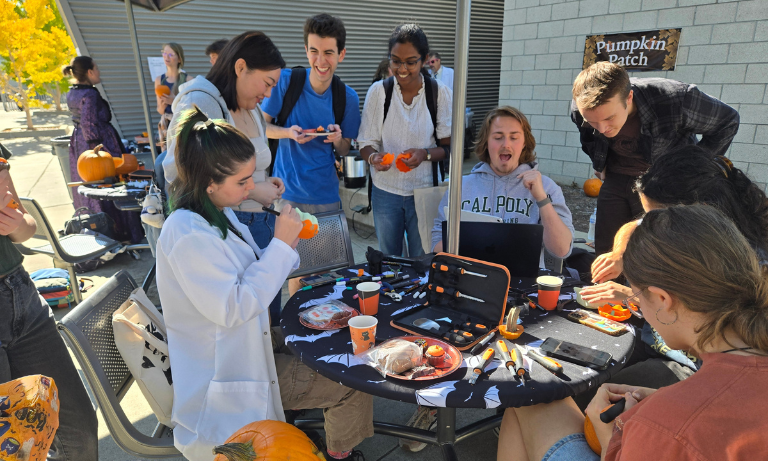When structural engineering Professor Giovanni De Francesco set out to address California’s earthquake challenges, he realized theory alone wouldn’t be enough. To truly understand how quakes affect timber houses — the backbone of the state’s residential buildings — he needed a bold approach.
His plan? Build a full-scale structure and push it to the limits on Cal Poly’s seismic shake table.
“I wanted to tackle something big,” said De Francesco, who joined the College of Engineering in the fall of 2023 with a vision of advancing earthquake testing and finding ways to reduce the economic toll of temblors.
His project aligns with California’s evolving building standards. Just two years before his arrival, the state updated its building codes to allow wooden buildings up to 18 stories high — expanding the use of timber for taller structures. While the new codes aim to enhance the sustainability of the built environment, De Francesco believes a greater impact can be made by improving the seismic resilience of residential timber houses, which are by far the most common type of structure in California.
The initiative has brought together master’s students, interns from France and civil engineering undergraduates, all united by a common goal: enhancing earthquake resilience in one of the world’s most tremor-prone regions.
“With our master’s students leading the charge and undergraduates now playing a key role, this could be the largest and most ambitious test ever conducted by students at a California state university,” De Francesco said. “It’s not just about learning — it’s about finding real solutions that could make a difference across the state.”
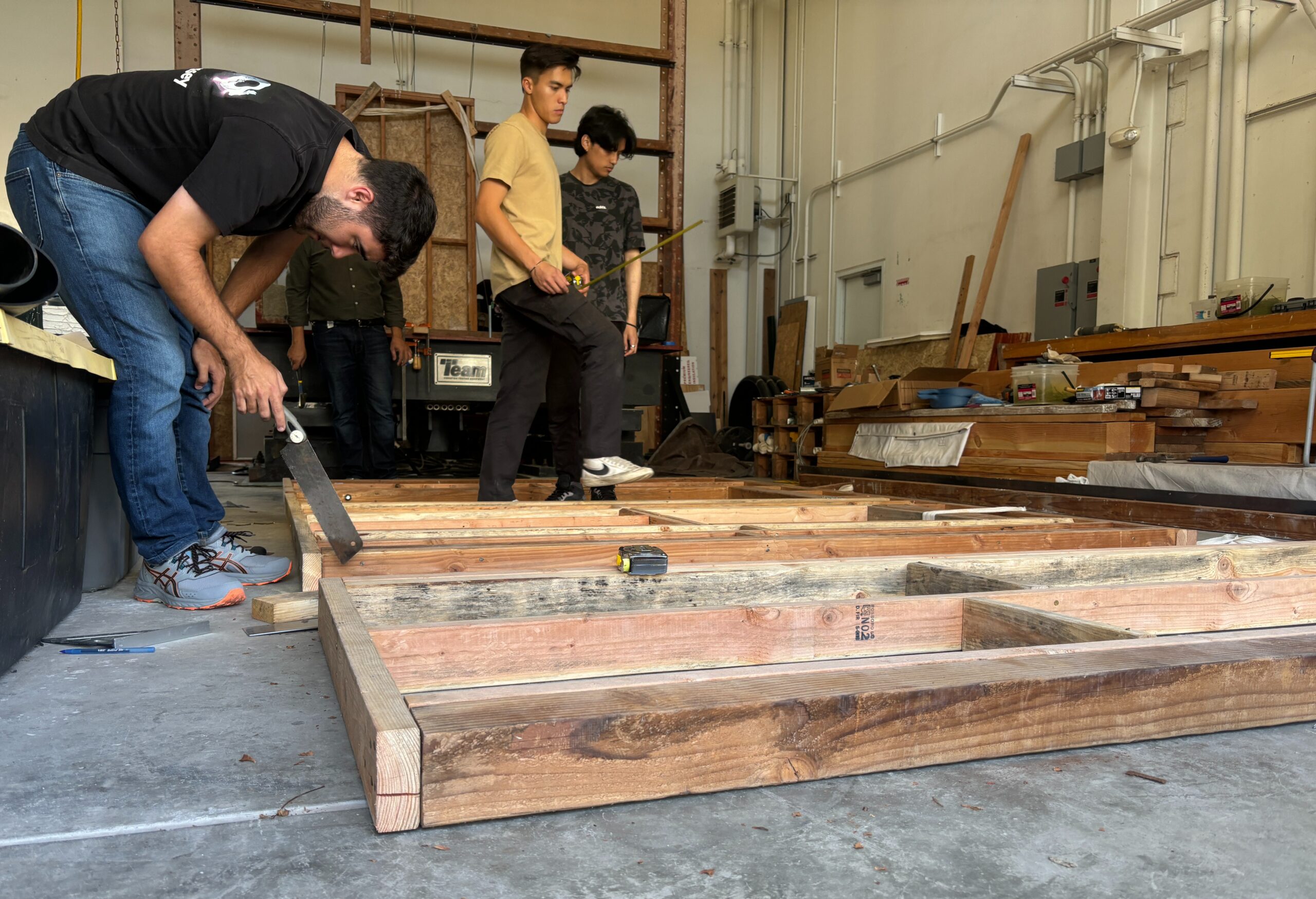
During his campus tour at Cal Poly, De Francesco made a key discovery. Tucked away in a tall, narrow building on North Perimeter Road, he found the Seismic Lab, a space brimming with potential. There, he spotted the perfect tool to bring his earthquake research to life: a shake table designed to mimic dynamic forces, such as earthquake ground motions.
He envisioned a full-scale timber structure, complete with light-frame walls, gypsum board, a sliding glass door, windows and a standard entry door — all set for rigorous testing on the shake table. Capable of holding up to 10 tons, the shake table can reproduce seismic movements at speeds up to 1 meter per second, replicating strong ground forces like those in a magnitude 7 event.
The first phase of testing will focus on a one-story structure, followed by the addition of a second story, complete with furniture to simulate real-world conditions. After assessing the damage, his team will repeat the test using an innovative self-centering wall system, designed to return the building to its original position after an earthquake, minimizing damage and improving resilience to aftershocks.
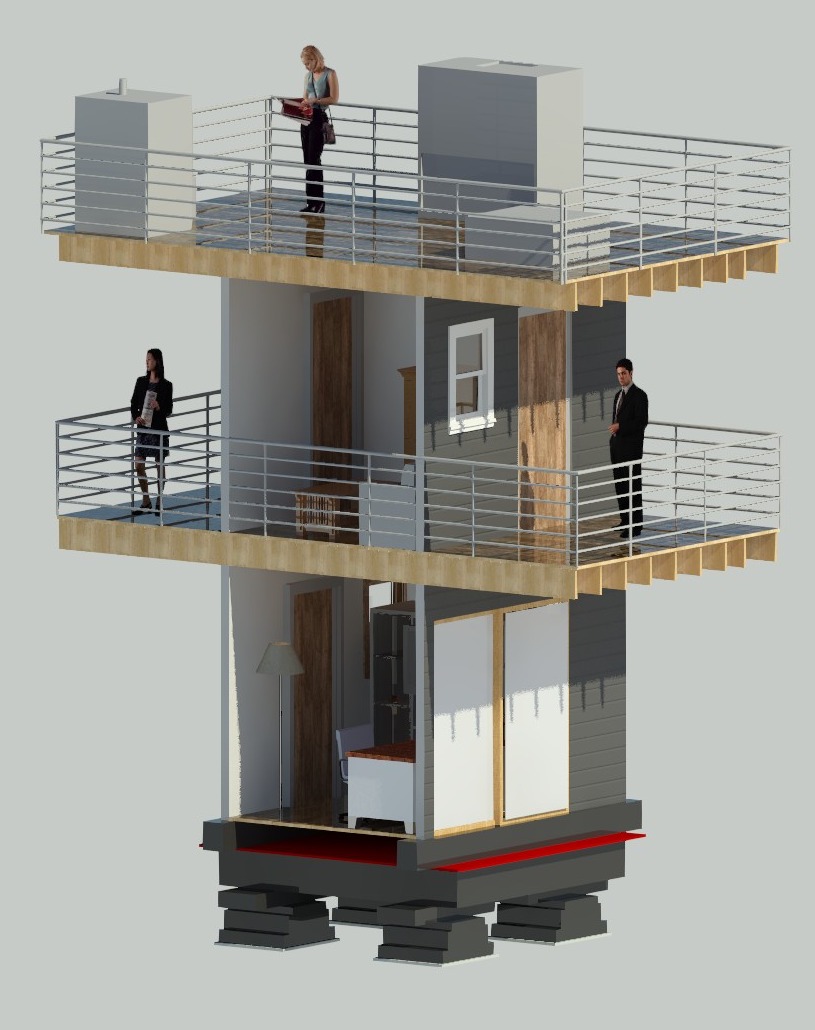
“This system could offer a cost-effective solution for homeowners in California,” De Francesco said, emphasizing its potential for widespread use in both residential homes and taller buildings.
His team has drawn on their diverse expertise, with each member playing a vital role, from calculation to construction.
Graduate students Min Khant of Yangon, Myanmar, Mason Leonard of Oakland, California, and Harrison Lane of Yorba Linda, California, have taken the lead, working closely with the undergraduates and international interns to bring De Francesco’s vision to life. As they stood by the shake table, surrounded by stacked lumber, the trio reflected on their work — a blend of technical problem-solving and physical labor. Together, they’ve poured concrete, started building timber walls and are inching close to completing the first floor.
“Structural codes have advanced to a point where they can prevent building collapse and save lives,” Leonard explained, “but they don’t address the economic losses that follow.”
Khant added that new generation building codes focus on immediate occupancy after an earthquake, ensuring structures remain safe and usable right away. “But that still leaves the challenge of addressing long-term economic damage,” he noted.
Lane, who joined the project after responding to De Francesco’s call for students interested in structural research, has found it both educational and personally rewarding. “It’s been such a great learning opportunity, but honestly, it’s been a lot of fun, too.”
De Francesco reflected on how the team has evolved, both in their skills and collaboration.
“When people work together, cultural barriers fall away. They struggle together, spend time together and yes, even complain together,” he said with a chuckle. “Those relationships can be just as valuable as the work itself.”
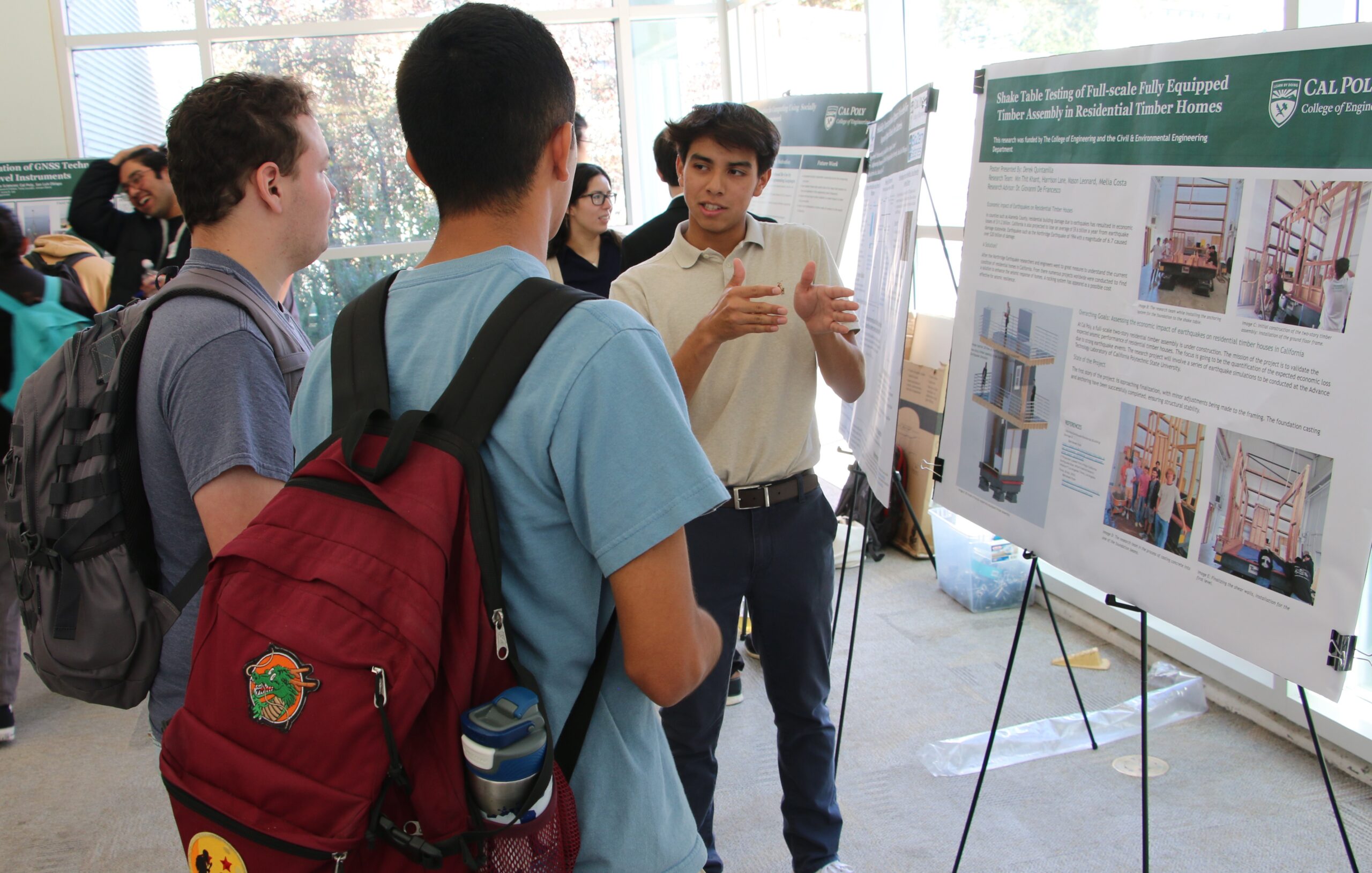
By the time summer rolled around, the project team had expanded, welcoming international interns from France and undergraduate students from Cal Poly’s Summer Undergraduate Research Program.
Simon Aperce, Julien Guillet and Louis Piumetto, students from CESI La Roche-sur Yon in France, joined the team for a one-month internship at Cal Poly, marking their first visit to the United States.
All three, who mainly work with concrete in their studies and part-time jobs, found the experience of learning about timber construction eye-opening, offering them a fresh perspective on building methods — especially in regions like California, where timber’s flexibility and lighter weight provide an advantage during seismic events.
“We tried to help as much as we could,” Guillet said. “They needed manpower, and we were happy to pitch in.”
Beyond the technical skills, they enjoyed the cultural exchange, practicing their English with their Cal Poly counterparts. They also embraced new traditions, like Taco Tuesday, which quickly became a favorite part of their time on the Central Coast.
Meanwhile, civil engineering undergraduates Melia Costa of Bend, Oregon, and Derek Quintanilla of Visalia, California, became part of the project through the Summer Undergraduate Research Program, gaining hands-on experience that extended beyond the classroom.
“The grad students have been amazing resources for us,” said Costa, who focused her efforts on the self-centering wall system, typically used in high-rises. “It’s been a great opportunity to apply the technology to residential structure, and I think this system could really benefit homeowners near fault lines.”
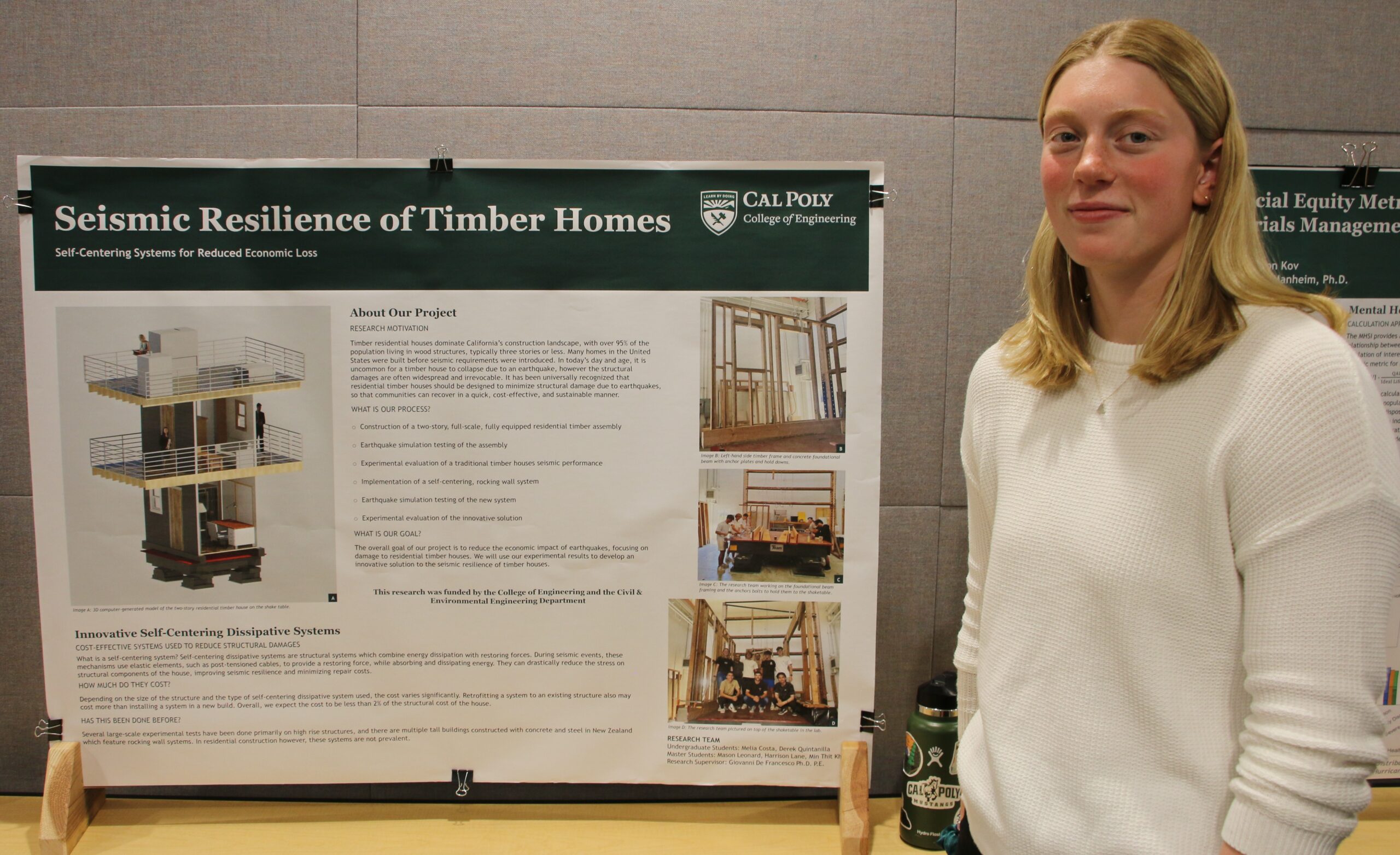
Quintanilla centered his research on the ripple effects of earthquakes, examining how the immediate impacts extend to schools, businesses and new construction.
“Before this project, I had no idea earthquakes triggered so many indirect issues,” he admitted.
Eager for hands-on experience, Quintanilla was ready to roll up his sleeves and dive into the physical aspects of the project. “This was my first major experience with Learn by Doing,” he said, “and it’s been exciting to see how classroom knowledge translates into real-world work like this.”
The graduate students will continue their work into the school year, staying on through the second-story testing as they finalize their theses. But for De Francesco and his team, this is only the beginning of what they hope will be a long-lasting impact on earthquake resilience research in California — and beyond.
“It’s been a valuable experience for everyone,” De Francesco said, “and we’re just getting started.”
By Emily Slater

